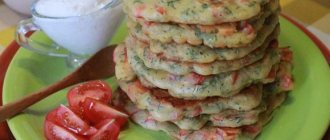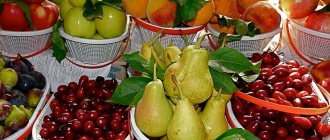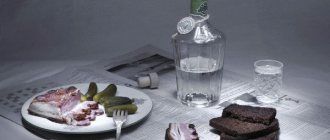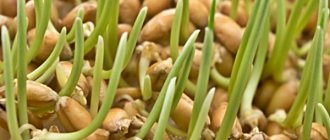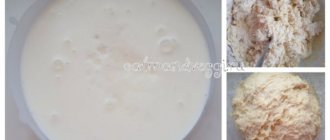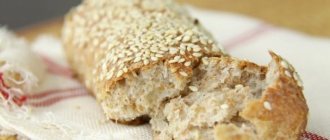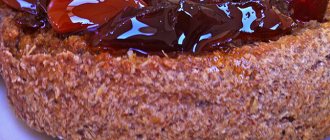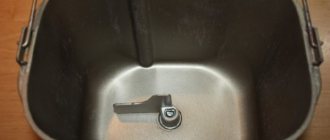Description
Whole grain flour is a food product obtained by single grinding of unrefined grains. Coarse flour has many varieties, but the most popular is wheat flour, which will be discussed further in the article. Whole grain flour is healthier and more nutritious than white flour, which is commonly used for baking baked goods. People who adhere to a healthy and proper diet and also follow a diet often add dishes made from coarse flour to their diet.
a brief description of
Whole grain flour differs from regular white flour in appearance, taste, cooking characteristics and beneficial properties.
What does whole wheat flour mean?
This is flour consisting of large particles of grain, cereals, seeds or other crops suitable for processing. Such flour is not widely used in baking, since it does not have the usual airiness and does not rise as well as white flour. At the same time, whole grain is a healthier product, since it contains fully ground grains with a shell (which contains fiber necessary for good digestion), rather than selectively selected particles, ground to a fine crumb state and devoid of most of the useful elements.
Production technology
The grain together with the shell is crushed once, without initial cleaning or further sorting of the grains into varieties (based on their size and quality). The grains are not sifted or re-grinded, due to which more useful elements are retained in whole grain flour.
Whole grain flour is sometimes called single-grind flour, where the name is fully justified by the production technology.
What does it look like?
Externally, whole grain flour resembles semolina with large particles of different sizes that do not have a uniform structure. The color is not snow-white, but dark with a gray or brown tint. However, after cooking, products made from coarse flour acquire a more appetizing and rich yellow color than baked goods made from white flour.
Taste
Baking using whole grain flour has a concentrated wheat flavor and aroma. However, the dough turns out to be denser in structure and not as airy as when using white flour.
What wheat is premium flour made from?
To make premium flour, the same raw materials are used as for others, but the production technology is different. It includes several stages:
- Preliminary cleaning of grain in the separator from contaminants and tendrils.
- Grinding grains in a mill. At the end of the process, the raw materials are poured into the collection compartment.
- Sifting, during which the product is cleared of all excess impurities and particles.
- Packing.
Thanks to this processing, the flour has a snow-white color and consists of the finest particles of endosperm in the upper layers, approximately 0.1 mm in size.
The influence of wheat gluten on the quality indicators of flour
Premium flour is rich in gluten, or gluten. This is an insoluble protein, thanks to which flour has excellent baking properties. It produces a porous, airy pastry, but such products are very high in calories and are not good for health, especially for the digestive and endocrine systems.
Types of whole grain flour
Depending on what raw materials were used for processing (grain, cereals, seeds), whole grain flour can be buckwheat, oatmeal, flaxseed, etc.
Amaranth
It is produced by mechanical grinding, which leaves no waste. The flour is made from whole amaranth grains. It has high nutritional value, making it suitable for baby food. © https://ydoo.info/product/celnozernovaya-muka.html Used as an additional component when preparing porridge, minced meat, dough, breading, as well as thick soups or extracting aromatic oil.
Buckwheat
Produced by one-time grinding of whole grains of unroasted buckwheat. It is distinguished by its gray color with a brown tint and a characteristic buckwheat aroma. The taste is slightly bitter, which is natural for buckwheat. The glycemic index is 40, the vegetable protein content is high.
The flour is suitable for diabetics and vegetarians. Used in dietary nutrition, it is beneficial for human health due to its rich content of macro- and microelements.
Linen
It is made by processing whole flaxseed while preserving all the beneficial elements and oil. Flaxseed flour is completely absorbed by the body. On sale you can find a product with and without gluten. Due to its low carbohydrate content, flour is suitable for dietary nutrition and is also suitable for people with type 1 and type 2 diabetes. Used for baking yeast products, unleavened dough, as well as for breading, preparing soups, minced meat, sauces and casseroles.
Oatmeal
Produced by slowly processing unroasted oat grains in a shell. The composition retains all the beneficial components of oats along with vitamins and minerals. The flour contains gluten and is therefore not suitable for people with celiac disease. It has a mild oat flavor and aroma and is used for baking dietary desserts, making jelly and pancakes.
Wheat
It is obtained by grinding unrefined wheat grains without further sifting and re-crushing. According to GOST, the yield of raw materials is 95%. The flour has a light gray color, large particles and a characteristic wheat aroma. Used for making bread, loaf, pizza dough, as well as gingerbread and other baked goods.
Rye
It is made by one-time grinding of whole rye grain, during which all the beneficial properties of the product are preserved. It is distinguished by a dark gray color with a brown tint. Used for baking table bread. Can be used for baking, combined with wheat flour.
Rice
It is made by one-time grinding of whole rice, peeled from the first layer of husk. It is distinguished by its gray color and lack of odor. Gluten free. It is widely used in oriental dishes, and is also suitable for baking dietary desserts. Suitable for children and people on a healthy diet.
Barley
It is made by grinding whole barley grains; its properties are similar to rye flour. It is distinguished by a large amount of fiber, tart taste and aroma with light nutty notes. Used to make pancakes, cookies, pancakes and bread (in combination with other flours). In addition, it is a good thickener for soups, sauces and gravies.
What is rye flour
Such raw materials were very often used in Rus' for cooking. Not many people know that it is a storehouse of vitamins and microelements. Unlike wheat, rye is much more resistant to temperature changes. Therefore, it is possible to grow it in most of Russia.
The basis of the composition of this raw material is protein. In addition to it, there are also carbohydrates and fats, although in small quantities. Microelements included in the composition:
- Calcium.
- Potassium.
- Phosphorus.
- Magnesium.
- Iron.
Vitamins included:
- E.
- WITH.
- IN 1.
- AT 2.
- AT 9.
The benefits of this raw material are due to the large amount of vitamins in the composition, as well as the relatively low calorie content and specific grinding, which has a positive effect on digestion.
How is whole wheat flour different from other types?
Depending on the grinding, flour is divided into different grades, differing in grain size, quality, color and composition.
From regular wheat
Whole grain flour retains all the beneficial elements and contains a large amount of fiber, which promotes good functioning of the gastrointestinal tract and better absorption of nutrients.
During the production of regular white flour, wheat grains are crushed twice and carefully sifted so that only the smallest particles are sold, making the baked goods more tasty and the dough more pliable for cooking, but less healthy for the body.
From peeling
Before grinding, the grains are cleaned by peeling off the top husks, which is how the variety got its name. Particles of the upper shell still get into the flour, but in smaller quantities, so it is healthy, but at the same time becomes more suitable for fluffy baked goods.
From wallpaper
Flour, which is made from whole grains without preliminary cleaning and further sifting, is called wallpaper. Whole grain flour and wallpaper are the same product.
From whole ground
Whole grain and whole milled flour are the names of the same product, which is made by grinding whole grains that have not been peeled.
Is rye flour good for diabetes and cholecystitis?
Rye flour is useful for diabetes and cholecystitis, but the use of products made from it is associated with some restrictions. Considering the properties of the product, the benefits and harm that they can cause to the body, the permissible dose for patients with diabetes is limited to 300–350 g, and then only due to long-term carbohydrates.
Consumption for cholecystitis is limited to the period of remission and the daily allowance of 150 g. Bread and pastries should be slightly stale. The same norm is prescribed for patients suffering from low acidity.
How to choose?
You only need to buy flour that is sold in paper packaging, since the product “breathes” in it. Plastic packaging causes the flour to develop a musty smell and self-heating processes begin. The packaging must be airtight, as contact with air can cause bugs to appear in the flour.
You also need to pay attention to the expiration date. Expired goods lose their flowability and microorganisms grow in them. The flour should be crumbly, without lumps, as well as black spots, bugs or larvae.
Rye flour of the Tverdokhleb brand
I became acquainted with this flour recently and have been testing it for a month now on both rye sourdough and rye dough. At the moment, I am completely satisfied with this flour in all respects, including quality, taste, smell and packaging design. Another thing I liked was the double paper packaging. The flour does not crumble and the place where it is stored always remains clean.
I give rye flour from the Tverdokhleb brand 5+.
How to make it yourself at home?
You can grind flour using a manual or electric mill, coffee grinder, blender or food processor (the more powerful, the better). Coarse grinding works best with handheld devices such as mills and coffee grinders, but a blender can be adjusted.
The grains should be thoroughly washed to get rid of external contaminants (lint, debris, etc.), dried and sorted to avoid spoiled ones. The grains are then crushed into grains approximately 0.5 mm in diameter.
It is better to grind the raw materials in small batches to monitor the grind size.
After this, you need to sift the flour, discard small particles, and place those remaining in the sieve on a kitchen paper towel in one layer and place in a room with good ventilation.
In order for the flour to dry well, the layer should not exceed 2 cm. The workpiece must be stirred periodically, lifting the lower grains to the top. When the flour stops sticking to your hands, you can pour it into a paper or cloth bag and use it within a month, storing it in the refrigerator.
Is it possible to make this flour yourself?
If there is no desire to spend extra money on an expensive product, buy wheat grains and prepare whole grain flour at home. Household appliances that are available are used as a processing tool:
- electric or manual mill;
- blender;
- food processor;
- coffee grinder;
- spice grinder
Thoroughly ground grains are dried on a paper towel or parchment sheet. Store the product in a fabric or paper bag for no more than a month.
How to store?
Due to its composition rich in vitamins and minerals, whole grain flour requires special storage conditions under which the product does not lose its beneficial qualities.
Conditions
Whole grain flour should be stored in a cool, dark place with moderate humidity. After opening the package, the flour must be placed in the refrigerator to preserve its beneficial properties.
You can leave the flour in its original packaging, but tightly close the opening area with a special clamp or clothespin. You can also pour the flour into a glass jar or container with a tight lid.
Term
On average, the shelf life of flour ranges from 6 to 12 months. If the flour begins to taste bitter, sour, or smell strange, then this is a sign that the product is spoiled.
Properties of tsz flour
From the point of view of benefits for the body, unrefined grain products are better; they contain more valuable substances, and not just starch. That is why they are so popular and are used in dietary nutrition, vegetarianism, diabetes and weight loss.
Chemical composition
The beneficial properties of a product are directly related to its chemical composition. Flour made from whole grains contains:
- starch 55%;
- fiber 2%;
- protein 12-13%;
- unsaturated fatty acids 2%.
In addition to these substances, it is rich in vitamins A and E, macro and microelements, especially manganese, iron, magnesium, and phosphorus.
Glycemic index of whole grain flour
Due to the presence of a large amount of fiber, all coarsely ground products have a lower glycemic index; they do not cause a sharp increase in glucose levels. Thus, the glycemic index of premium wheat is 95 units, and peeled wheat is 65.
Whole grain flour made from rye, wheat, buckwheat or spelled has a GI of 40-45 units. The lowest indicator is for products made from chickpeas and soybeans, it is in the range of 25-35 units.
Is there gluten in whole wheat flour?
The term “whole grain” only refers to the degree of grinding, so the crop the product comes from is critical. The most common wheat and rye. They are both rich in gluten - specific proteins that form gluten. These proteins are also found in oats and barley, so products made from them will contain gluten. Gluten-free flours include rice and buckwheat flour, as well as those made from corn or peas.
Calorie content of whole grain flour
In terms of energy values, different types of flour made from wheat or rye do not differ much. Products made from premium wheat contain 330 Kcal per 100 g, the wallpaper variety contains 320 Kcal. Rye wallpaper and peeled have an energy value of 320-325 Kcal/100g. A product made from whole grains of rye or wheat provides 340 Kcal due to the fact that, although it contains less starch, it contains more fat.
Best before date
The shelf life of grain products depends on its chemical composition, especially on the amount of fat, as well as the general contamination with microorganisms. Here, premium flour has the advantage: it will not lose its properties in a dry room for up to 12 months. The product from whole grains will deteriorate faster: after 3-4 months it begins to go rancid. It is better to keep it in the refrigerator or freezer, but always in an airtight bag.
Important! You cannot use flour directly from the freezer for baking; it must warm up to room temperature. This is especially important for yeast dough.
Use in cooking
Whole grain flour has extensive use in cooking, as it is not only suitable for dietary nutrition, but is also healthy and nutritious.
How to knead dough from whole grain flour?
Due to the fact that whole grain flour is more coarsely ground than regular white flour, there are some things to keep in mind when preparing the dough, namely that it does not rise as easily as all-purpose flour.
For pizza
To prepare pizza dough, you need to use 100 g of whole grain flour and 30 g of premium flour, as well as 50 ml of warm water, 5 g of dry yeast, 1 tbsp. l. vegetable oil and spices to taste.
All flour must be sifted and mixed with salt, butter and pre-suited yeast. Then the workpiece is thoroughly mixed and placed in a warm place for about half an hour so that the dough rises.
For bread
To make bread dough, you need to take 500 g of whole grain wheat flour, 15 g of fresh yeast, 2 tbsp. l. vegetable oil and 350 ml of water. Salt and sugar are added to taste, but about 2 tsp. first and 1 tsp. second.
Grind the yeast with sugar in a small bowl, adding 1 tsp. flour, add warm water, cover with film and leave for 7 minutes in a warm place. Then you need to mix the flour with salt and add the yeast that has begun to ferment. The dough should be kneaded thoroughly, it should remain a little sticky, and then add vegetable oil and knead a little more. After this, the workpiece needs to be transferred to a deep container, covered with film, put in a warm place for about 1.5 hours - and you can bake.
Custard for dumplings and dumplings
To prepare choux pastry, you should take 1 cup each of whole grain and regular wheat flour, ¾ cup boiling water, 1 tbsp. l. butter and a pinch of salt. In a deep container you need to mix the sifted flour (also pour the remainder of the whole grain flour into a bowl). Make a hole in the center of the container and pour salt into it.
In a separate pan, you need to heat water with the addition of a piece of butter and wait for it to completely dissolve. Then hot water should be poured into the flour in a thin stream, vigorously mixing the contents. After all the liquid has poured out, you need to continue kneading the dough with your hands for 7 minutes on a floured table (use white flour). If the dough is too sticky, you should add a little extra flour.
Then the dough needs to be transferred to a suitable bowl, covered with a lid or film and put in a warm place for half an hour.
Shortbread dough
To make shortbread dough, you need to take 180 g of whole grain flour, 100 g of butter, 1 chicken egg and sugar to taste. All ingredients must be mixed in the bowl of a food processor or deep bowl and knead until a homogeneous mass is formed.
Unleavened dough
To prepare unleavened dough you need to take 150 g of flour, 100 ml of boiling water, 1 tbsp. l. vegetable oil and 0.5 tsp. salt. In a deep container, mix flour with butter and salt, make a well in the center and begin pouring boiling water in a thin stream, continuously and intensively stirring the mixture. Then the mixture should be covered with a cloth and placed in a warm place for half an hour to allow the dough to rest.
Butter yeast for pies
To make butter dough with milk, you need to use 200 ml of water, 200 ml of milk, 300 g of whole grain flour, 300 g of plain flour, 100 g of butter, 1 egg, 30 g of fresh yeast, 2 tsp. salt and sugar to taste.
First you need to make a dough by mixing yeast, sugar and 150 g of white flour in a warm liquid consisting of milk and water. Leave the dough for 30 minutes. After this, you need to add salt, melted butter, egg, whole grain and white flour in order. Then knead the dough on a floured table until it stops sticking to your hands. Then the dough needs to be transferred to a bowl, covered with a cloth and left warm for an hour.
Puff pastry
To prepare puff pastry you will need to take 0.5 kg of whole grain flour, 400 g of cold butter, 1 chicken egg, 1 tbsp. l. lemon juice, a pinch of salt and water.
Sprinkle the flour evenly on the work surface, grate the butter on top using a coarse grater, and mix the ingredients thoroughly. Then the workpiece needs to be put together and a depression made in the center. In a measuring cup, mix the egg, lemon juice and add water so that you get 250 ml of liquid in total. The liquid should be poured into the flour mixture and the dough should be thoroughly kneaded, wrapping the mixture from the edges to the center. After this, the dough must be transferred to a bag or wrapped in plastic wrap and left in the refrigerator for 2 hours.
Features of baking from whole grain flour
Due to the coarse grind, dough made with whole wheat flour takes longer and is harder to rise. To prepare fluffy baked goods, you should use only proven yeast, give the dough more time to rise, and be sure to air the flour before starting cooking to saturate it with oxygen.
If, after following all the recommendations, you still cannot make fluffy baked goods, you need to dilute the whole grain white flour in a 1:1 ratio. In addition, during baking there is no need to open the oven so that the dough does not fall.
What can I substitute in the recipe?
You can replace whole grain flour with regular premium flour, but use a little more, for example, 100 g of whole grain flour equals 120 g of white flour.
You can also use regular premium flour with a small addition of wheat germ or bran (10 g per 100 g of flour), but then you will need to increase the amount of water by 20 ml from the figure indicated in the recipe.
Preparation of paste
Let's learn how to make paste yourself.
If you are interested and decide to make wallpaper glue with your own hands, then our instructions will be useful to you:
- Take a metal enamel bucket and pour one-third to one-half of cold water into it. Pour 5 kg of flour sifted through a fine sieve into the water, stirring constantly so that there are no lumps. Stir the mixture until it has a homogeneous creamy consistency;
Mix the solution with cold water;
- Then add cool boiling water to the top in a thin stream into the same bucket. At the same time, we also carefully stir the solution so that it does not form lumps and is homogeneous;
Add boiling water in a thin stream.
- We put the boiled water on the fire and wait until it starts to boil. We put a rag or a layer of paper on the bottom, then put a bucket with the resulting solution there and bring it to a boil. When the substance has boiled, immediately remove it from the bath and strain through a colander made of fine metal mesh;
Strain the resulting material through a colander.
- After cooling, the product should be used immediately; it should not be stored for more than two days. Prepare as much as you can produce in a day.
Get to work right away, the material is not stored for a long time.
Important! The paste can be used as a primer for walls, but in this case it is better to apply it hot, after diluting it twice with boiling water.
Benefits and harms
Eating baked goods made with or with the addition of whole grain flour will have a positive effect on the functioning of the body as a whole.
The beneficial properties of this type of flour are as follows:
- blood sugar levels decrease, insulin spikes are not provoked;
- metabolism accelerates;
- the functioning of the respiratory organs improves, the course of asthma becomes easier;
- the risk of gallstones is reduced;
- the likelihood of cancer is reduced;
- the work of the heart muscle improves;
- the likelihood of developing Alzheimer's disease is reduced;
- the condition of the pregnant woman and fetus improves;
- blood pressure decreases;
- the functioning of the gastrointestinal tract improves;
- skin condition improves;
- bones are strengthened.
In addition, the body is saturated with essential vitamins and minerals. Baking made from whole grain flour can be eaten by pregnant women, nursing mothers and children.
Wholemeal flour can cause harm to people suffering from diseases such as gastritis, stomach or duodenal ulcers, allergies, individual gluten intolerance, colitis or other gastrointestinal disorders.
Whole grain flour for weight loss
Due to the fact that during grain grinding it is not cleared of the outer shell, which is rich in fiber, eating baked goods made from whole grain flour promotes weight loss.
Moderate consumption (no more than 100 g of baked goods per day) helps improve the functioning of the stomach and intestines. The body is cleansed of toxins, and food is not stored as fat, but is processed into energy, increasing the stamina and performance of the body.
Flour is valued by those losing weight for its low glycemic index and the content of “slow” carbohydrates, which take a long time to digest and give a feeling of fullness for a longer time. However, you should eat dishes made from wholemeal flour in the first half of the day and do not abuse the daily dose, since the calorie content of whole grain flour is not low (298 kcal per 100 g).
Whole grain flour is a healthy food product that is high in micro- and macroelements, as well as fiber. Dishes made from flour made by one-time grinding have a positive effect on the health of adults and children, and are also suitable for people following a diet, vegetarianism and a healthy diet.
Moderate consumption (no more than 100 g of baked goods per day) helps improve the functioning of the stomach and intestines. The body is cleansed of toxins, and food is not stored as fat, but is processed into energy, increasing the stamina and performance of the body.
Where to buy and how much it costs
Currently, whole grain flour is not a scarce commodity. It is sold both in large chain stores and in small retail outlets. The most popular brands: “S. Pudov”, “Ryazanochka”, “French thing”. The cost varies from 50 to 100 rubles. for 1 kg.
Despite the simplified production process, whole grain flour is a more expensive product than regular wheat flour. This is due to the fashion actively promoted by marketers for everything natural, environmentally friendly and unprocessed. Previously, this ingredient was the basis of the diet of the poor and cost a penny.
This is interesting:
What are the classes of wheat and how do they differ from each other?
Description of the variety and characteristics of winter wheat Ermak.

